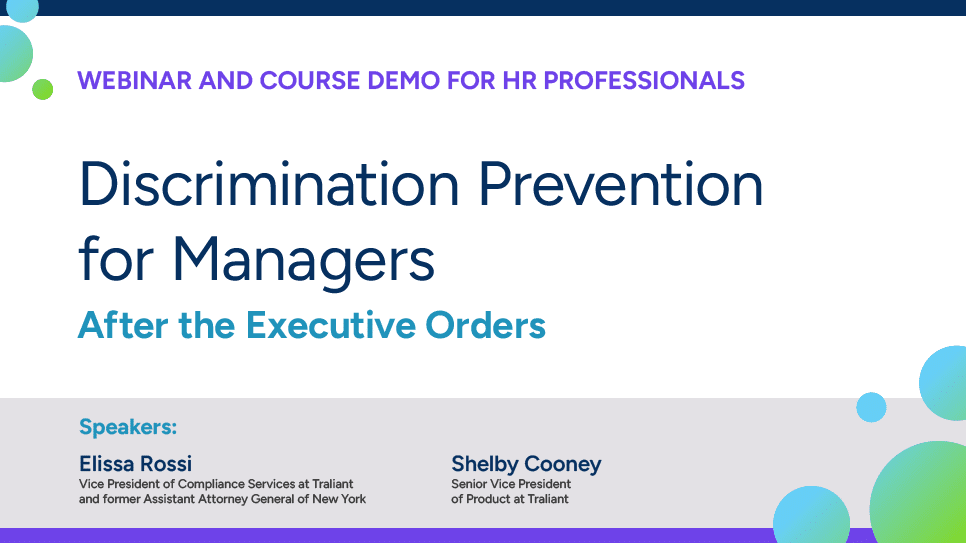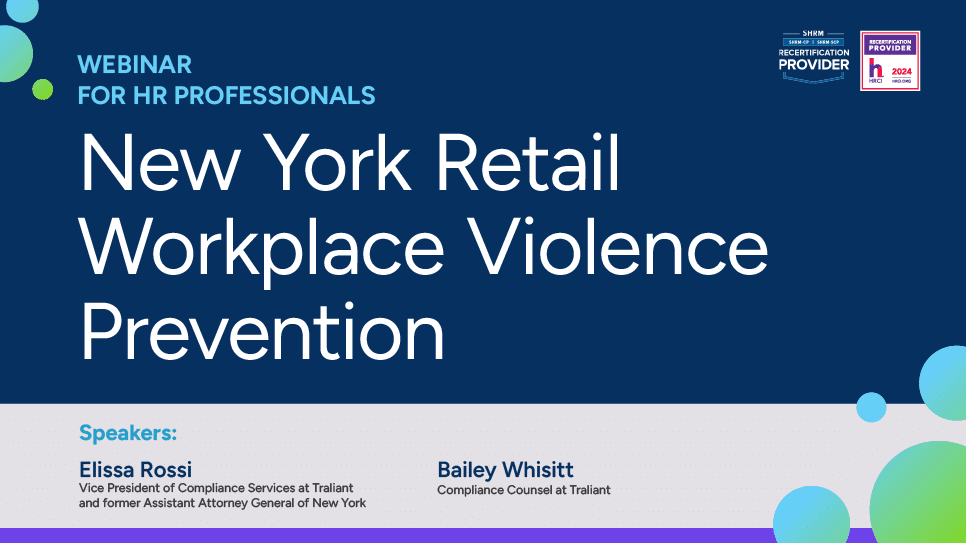

EEOC Approved Sexual Harassment Investigation Interview Questions
What Employers Should Know About Investigating a Complaint of Sexual Harassment
Do employees feel safe at work and how can employers address their anxieties?
When an employer receives a compliant of sexual harassment, it needs to investigate the incident immediately and know the right questions to ask to get to the heart of the matter. Proper handling of these complaints ensures a safe and respectful workplace, complies with legal obligations, and fosters a culture of trust.
It’s not easy to investigate claims of potential harassment in the workplace. You’re dealing with highly sensitive situations, and interviewees can include the complainant, harasser and third parties who witnessed the event. When a complaint is received, assure the complainant that their report will be handled confidentially, as much as possible. Be sure to record the details of the compliant immediately, noting the date, time and nature of the allegations.
Navigating EEOC Guidelines
The Equal Employment Opportunity Commission (EEOC) has guidelines that mandate employers to conduct investigations whenever they learn of any alleged harassment in the workplace. The EEOC also provides that after remedial action, the employer must make follow-up inquiries to ensure that the victim has not suffered any unlawful retaliation and that the harassment has stopped.
Managers and supervisors are obligated to report any complaints or observed harassment to HR immediately. HR and investigators are responsible for conducting fair, thorough and confidential investigations.
Here are a few things to keep in mind:
- The aim of a harassment investigation is to collect fair, accurate and detailed evidence of the nature of the complaint and present it to the employers, who then take action. It’s crucial to take good notes of each employee interview, as your documentation could become part of legal proceedings.
- Throughout the investigation, it’s crucial that the investigator remains impartial and has no conflicts of interest. The investigator’s job is to find the truth of how events transpired by gathering evidence, no sway in the outcome of the investigation.
- Gather all relevant evidence, such as emails, text messages, surveillance footage, and any other pertinent documents or records.
- You can customize the questions to fit a specific situation. Ask open-ended questions but avoid “leading” questions and comments. Questions often fluctuate between the parties, so adjust your interview questions accordingly.
Standard Procedure for Sexual Harassment Investigations
To ensure a fair and thorough investigation of sexual harassment complaints, employers should follow a standard procedure. This helps maintain consistency, transparency, and trust in the process. Below are the key steps involved in the standard procedure:
- Receiving the Complaint
- Record the details of the complaint immediately.
- Assure the complainant of confidentiality and explain the investigation process.
- Assigning an Investigator:
- Choose an impartial and trained investigator.
- Establish a clear timeline and process for the investigation.
- Interviewing the Complainant:
- Make the complainant feel comfortable and safe.
- Gather detailed information about the incident(s) and any potential witnesses.
- Interviewing the Alleged Harasser:
- Clearly communicate the allegations.
- Allow the alleged harasser to provide their account and any supporting evidence.
- Interviewing Witnesses:
- Inform witnesses of the importance of their cooperation.
- Ask objective questions to gather relevant information.
- Collecting and Reviewing Evidence:
- Gather all relevant documents, emails, messages, and other evidence.
- Ensure all evidence is documented and securely stored.
- Making a Determination:
- Review all collected information impartially.
- Determine whether harassment occurred based on the evidence.
- Taking Appropriate Action:
- Implement disciplinary actions if harassment is confirmed.
- Ensure both parties are informed of the decision.
- Follow-Up:
- Check in with the complainant and other involved parties.
- Ensure no retaliation occurs and provide ongoing support as needed.
- Preventing Retaliation:
- Communicate anti-retaliation policies clearly.
- Monitor the work environment for signs of retaliation.
- Provide support resources and conduct regular check-ins.
Clarifying Roles
The roles of employees reporting alleged sexual harassment can be difficult to ascertain at the outset, depending on the circumstances.
For example, an employee reports having observed what they think is sexual harassment and is offended by the incident or behavior. We would typically categorize this employee as a third party. However, if the employee who is perceived to be the “victim” of the alleged harassment does not make a complaint, and the original reporting party (what we might call the third party) confirms that they were offended and maintains there is an issue of sexual harassment – then that third party can become the complainant.
It’s rare that the alleged harasser takes on a different role in the investigation. However, it can happen, particularly in cases where they make a counter-complaint against the “victim” or complainant or the third party who may have reported the incident.
Questions to Ask the Complainant:
It’s important to establish trust during the interview process to make the complainant feel comfortable and safe. Gather details about the incident using these questions:
- Who, what, when, where, and how: Who committed the alleged harassment? What exactly occurred or was said?
- When did it occur and is it still ongoing? Where did it occur? How often did it occur? How did it affect you?
- How did you react? What response did you make when the incident(s) occurred or afterwards?
How did the harassment affect you? Has your job been affected in any way?
- Are there any people who have relevant information? Was anyone present when the alleged harassment occurred? Did you tell anyone about it? Did anyone see you immediately after episodes of alleged harassment?
- Did the person who harassed you harass anyone else? Do you know whether anyone complained about harassment by that person?
- Are there any notes, physical evidence, or other documentation regarding the incident(s)?
- How would you like to see the situation resolved?
- Do you know of any other relevant information?
Questions to Ask the Alleged Harasser:
When interviewing an alleged harasser, it’s important to clearly communicate the allegations without revealing the complainant’s identity unnecessarily. Get their account by asking these questions:
- What is your response to the allegations?
- If the harasser claims that the allegations are false, ask why the complainant might lie.
- Are there any people who have relevant information?
- Are there any notes, physical evidence, or other documentation regarding the incident(s)?
- Do you know of any other relevant information?
Questions to Ask Witnesses:
When interviewing third party witnesses to an incident, explain the purpose and explain that their cooperation is crucial for a fair investigation. Questions to ask include:
- What did you see or hear?
- When did this occur?
- Describe the alleged harasser’s behavior toward the complainant and toward others in the workplace.
- What did the complainant tell you? When did they tell you this?
- Do you know of any other relevant information?
- Are there other people who have relevant information?
Protection from Retaliatory Actions
Retaliation occurs when an employer or co-worker takes adverse action against an employee for reporting sexual harassment or participating in an investigation. This can include termination, demotion, negative performance reviews, or harassment. It’s crucial for employers to have clear anti-retaliation policies and to communicate these to all employees, ensuring that anyone who reports harassment or supports those who do is protected from any negative consequences.
Employers should implement robust measures to ensure that complainants and witnesses involved in an ongoing harassment investigation are not subject to retaliatory behaviors. This involves:
- Clearly communicating anti-retaliation policies to all employees and emphasizing the serious consequences of such actions.
- Provide multiple channels for reporting retaliation, including anonymous … and ensure employees know how and where to report concerns.
- Closely monitoring the work environment for signs of retaliation and regularly check in with complainants and witnesses to assess their well-being.
- Promptly address any reports or signs of retaliation and take appropriate disciplinary action against those who engage in retaliatory behaviors. Keep thorough records of all complaints, investigations and follow-up actions, and document any measure taken to prevent retaliation.
- Offer support resources such as counseling services and adjust work schedules if needed to protect those involved.
- Conduct training sessions on recognizing and preventing retaliation and ensure managers and supervisors understand their role in preventing retaliation.
Fostering Trust and Accountability
Effectively investigating sexual harassment complaints is paramount for any organization committed to fostering a safe and respectful workplace. This diligent approach not only fulfills legal obligations but also reinforces a culture of trust and accountability. By handling complaints promptly and thoroughly, employers protect the rights of all parties involved and address employees’ anxieties and ensure they feel safe. A robust investigation process, combined with clear anti-retaliation measures, demonstrates a company’s dedication to justice and employee well-being. These efforts contribute to a more positive and inclusive work environment, where every employee can thrive without fear of harassment or retaliation.
Download EEOC – Approved Sexual Harassment Investigation Interview Questions to learn more.

